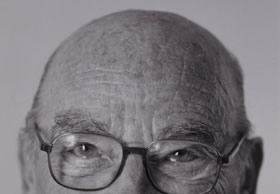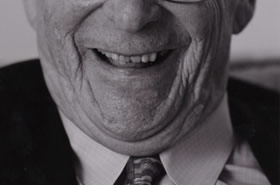 |
| My encounter with enzymes |
 |
 |
My parents emigrated from Eastern Europe to New York in 1900. We were a very poor family, so my objective became medical school, which I saw as the only way I could continue my studies. I intended to become a physician. I served as a medical officer in the United States Coast Guard, but a paper I wrote on jaundice while a medical student caught the attention of the director of the National Institute of Health, and I wound up working in the Nutrition laboratory.
At that time, vitamins essential to life were being discovered, and initially I tried to find new vitamins. Then, I became aware of enzyme research conducted by biochemists. I realized that enzymes were the source of the vital power of life, the site at which vitamins functioned, and they were a means to understanding living creatures in chemical terms. I then resolved to become an enzyme hunter.
I became interested in tracking down the enzymes that synthesized the respiratory coenzymes NAD and FAD, and wondered how nucleotides functioned to form nucleic acids. That's how I arrived at the enzyme that replicates DNA. When I focused on this enzyme, I found one of the key elements in DNA research of the time. This success was recognized, as was the work of Dr. Severo Ochoa, with RNA, by the award of the Nobel Prize for Physiology or Medicine in 1959. |
 |
| A molecular fossil comes to life |
 |
 |
Despite my devotion to the enzymes that replicate DNA, I felt that future directions would take me into areas of structure and biology in which I felt less secure than in the discovery and characterization of enzymes.
For many reasons I was drawn to a novel but far less glamorous polymer, inorganic polyphosphate (poly P). This polymer made up of hundreds of phosphate residues, linked by high-energy bonds as in ATP, is found in every cell in nature—bacterial, viral, plant and animal. Yet for lack of knowledge of its functions, it was regarded as a “molecular fossil”. I had the conviction that a molecule so widely conserved at a high energetic cost must be important. My objective was to discover the enzymes that make and use poly P and bring this molecule to life.
In our discoveries of the enzymes in a wide variety of bacteria, and most recently in plant and animal cells, we now have evidence that poly P because of its many essential functions is responsible for the origin and survival of species. One of the startling recent discoveries is an enzyme that assembles itself from a globular state into actin-like filaments concurrent with the synthesis of poly P chains. The reaction is reversible and dynamic. It seems likely that such reactions are basic events in cells that include: contractility, phagocytosis and cytokinesis.
|
Remarkably little attention has been paid to poly P even though we have shown that bacterial virulence in many cases depends on poly P. In the case of serious infectious diseases, as well as in some cellular dysfunctions, poly P plays a vital role. Yet, as has often happened in science, it may take many years for a discovery to be appreciated and applied.
Too often basic discoveries are neglected. That has happened time and again. For example, I do not know whether stem cell research will be useful in curing Parkinson's disease or Alzheimer's. But it is important to know how stem cells work and how they develop. There are many projects and roadmaps in Japanese science, but I am concerned that there are too few people to support the foundations needed for applications.
|
When my three sons were small, I often told them Germ Stories. These ranged from such pathogenic germs as Staphylococci to the bacteria I used as research material. Several artists once tried to render illustrations for my stock of stories, but they never succeeded. Unfortunately, bacteria have no nose, eyes, or ears. How should they be drawn so children will be interested in them? Bacteria do swim and flee. I hope that someday, someone will be able to present stories for children that skillfully capture their essence and wonder.
The Biohistory Research Hall does a wonderful job in its presentations of exhibits and publications that focus on basic science. It is a unique activity to convey science to everyone. I very much hope that this great work continues into the future.
|
|
 |
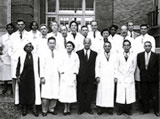 |
 Paul Berg (winner of Nobel prize of chemistry 1980) and Osamu Hayaishi (Professor Emeritus of Kyoto University, Chairman of the Board of Trustees of Osaka Bioscience Institute) joined the laboratory. (Courtesy of Dr. O. Hayaishi, from Biohistory Journal, Vol. 28.) Paul Berg (winner of Nobel prize of chemistry 1980) and Osamu Hayaishi (Professor Emeritus of Kyoto University, Chairman of the Board of Trustees of Osaka Bioscience Institute) joined the laboratory. (Courtesy of Dr. O. Hayaishi, from Biohistory Journal, Vol. 28.) |
 |
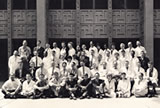 |
 At Stanford University in 1962. Biochemistry of DNA replication was elucidated here. Tsuneko Okazaki (Professor Emeritus of Nagoya University) and her late husband Reiji Okazaki (Professor of Nagoya University) joined. (Courtesy of Dr. T. Okazaki, from Biohistory Journal, Vol. 32.) At Stanford University in 1962. Biochemistry of DNA replication was elucidated here. Tsuneko Okazaki (Professor Emeritus of Nagoya University) and her late husband Reiji Okazaki (Professor of Nagoya University) joined. (Courtesy of Dr. T. Okazaki, from Biohistory Journal, Vol. 32.) |
 |
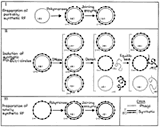 |
|
|
 Succeeded for the first time in the test tube synthesis of infectious viral DNA, using purified DNA polymerase. This story was big news and appeared as "Creating life in the test tube" in newspapers and TV worldwide. President Johnson also made the news by congratulating me. (Courtesy of A. Kornberg, from Goulian, M., et al. Proc Natl Acad Sci USA 1967 Dec 15; 58[6]) Succeeded for the first time in the test tube synthesis of infectious viral DNA, using purified DNA polymerase. This story was big news and appeared as "Creating life in the test tube" in newspapers and TV worldwide. President Johnson also made the news by congratulating me. (Courtesy of A. Kornberg, from Goulian, M., et al. Proc Natl Acad Sci USA 1967 Dec 15; 58[6]) |
 |
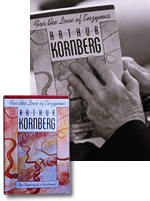 |
 "For the Love of Enzymes: The Odyssey of a Biochemist," autobiography that describes his research story and history of biochemistry. 1st prize winner of the American Medical Writers' Association Book Award. "For the Love of Enzymes: The Odyssey of a Biochemist," autobiography that describes his research story and history of biochemistry. 1st prize winner of the American Medical Writers' Association Book Award. |
 |
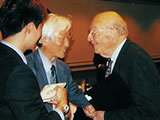 |
 During a reception when receiving a nomination of honorary member of the Japan Society in 2004. middle; Dr. Hiroshi Yoshikawa (JT BRH Adviser). During a reception when receiving a nomination of honorary member of the Japan Society in 2004. middle; Dr. Hiroshi Yoshikawa (JT BRH Adviser). |
 |
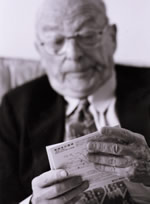 |
 Reporters for the Biohistory journal interviewed Dr. Arthur Kornberg visiting Japan last autumn, and the editor are responsible for the wording of this article. We will introduce fascinating stories of scientists in Japan and also all over the world. Reporters for the Biohistory journal interviewed Dr. Arthur Kornberg visiting Japan last autumn, and the editor are responsible for the wording of this article. We will introduce fascinating stories of scientists in Japan and also all over the world. |
|
